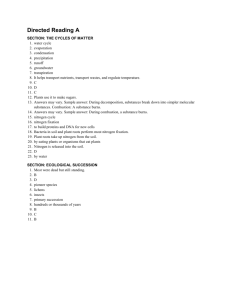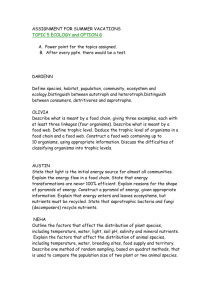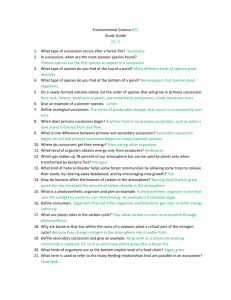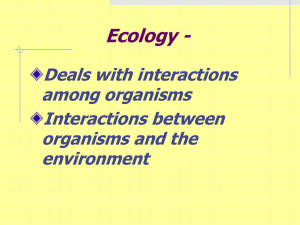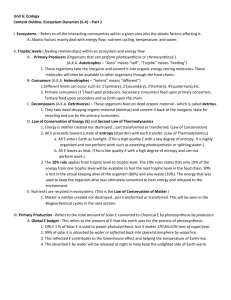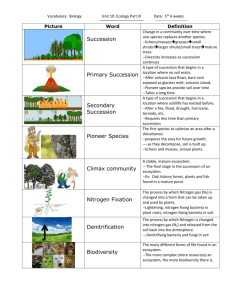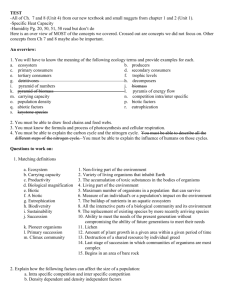Unit 10 – Energy Flow & Human Impact NOTES
advertisement
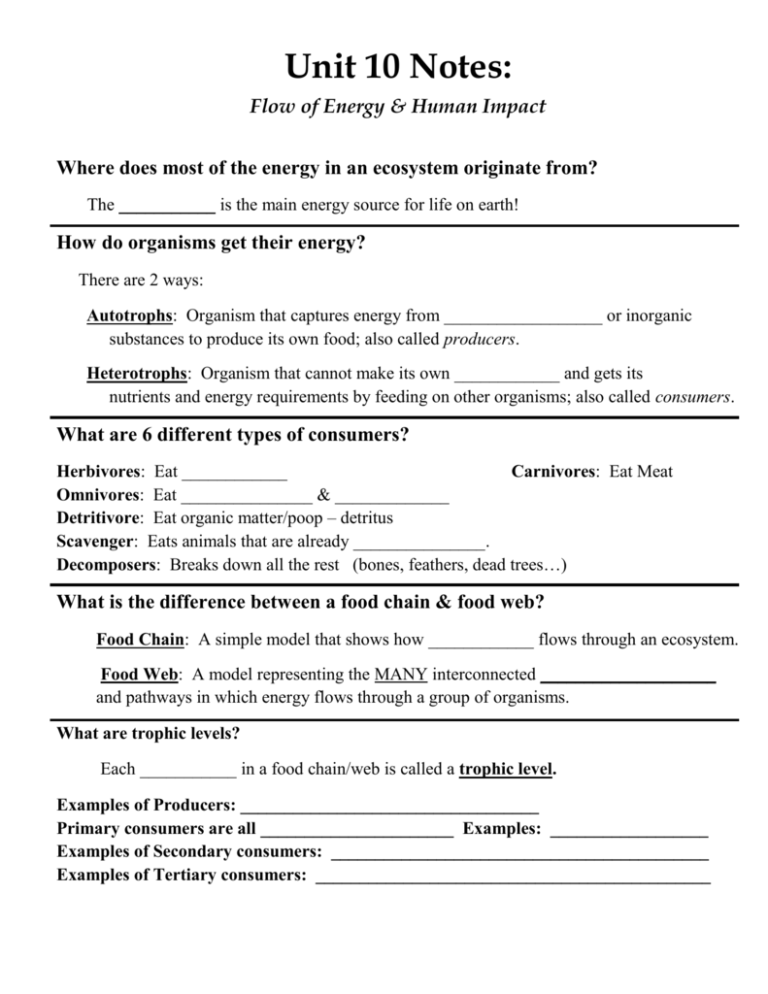
Unit 10 Notes: Flow of Energy & Human Impact Where does most of the energy in an ecosystem originate from? The ___________ is the main energy source for life on earth! How do organisms get their energy? There are 2 ways: Autotrophs: Organism that captures energy from __________________ or inorganic substances to produce its own food; also called producers. Heterotrophs: Organism that cannot make its own ____________ and gets its nutrients and energy requirements by feeding on other organisms; also called consumers. What are 6 different types of consumers? Herbivores: Eat ____________ Carnivores: Eat Meat Omnivores: Eat _______________ & _____________ Detritivore: Eat organic matter/poop – detritus Scavenger: Eats animals that are already _______________. Decomposers: Breaks down all the rest (bones, feathers, dead trees…) What is the difference between a food chain & food web? Food Chain: A simple model that shows how ____________ flows through an ecosystem. Food Web: A model representing the MANY interconnected ____________________ and pathways in which energy flows through a group of organisms. What are trophic levels? Each ___________ in a food chain/web is called a trophic level. Examples of Producers: __________________________________ Primary consumers are all ______________________ Examples: __________________ Examples of Secondary consumers: ___________________________________________ Examples of Tertiary consumers: _____________________________________________ What are ecological pyramids? Ecological Pyramid: Another model used to show how energy _______ through ecosystems. Can show: ● Amount of ____________ ● Amount of ____________ ● Number of organisms Biomass: The total ___________ of living matter at each trophic level. What is the 1/10th Rule? * The reason that each trophic level can support only __________ of the amount of living tissue as the level below it is because each trophic level harvests only about one tenth of the energy from the level below. The rest of the energy (90%) is LOST as HEAT ● _______________ ● Hunting for food ● Breathing ● _________________ ● Reproducing ● Maintaining body heat * Only _____% of energy moves up to the next trophic level Flow of Energy Video Questions: 1. Energy flows through the ________________________. 2. First energy is captured by the producers, those plants and microorganisms that can produce their own food by ________________________. 3. All of these different feeding levels or ________________ levels as they are called, form a type of energy pyramid. 4. Biologists estimate that on average only ______% of the plant’s accumulated energy is passed on to the body of the organism that eats it. 5. Where does the energy go? Some is used for digestion, _________, growth, & ___________. 6. At each trophic level, there is a decrease of about _____ % of energy that is available. 7. The biomass at the bottom level is so great, and replenishes itself so quickly, it can sustain the organisms at the _____________ levels. What are 4 different types of cycles in the biosphere? Nutrient: Is a ____________________ substance that an organism obtains from the environment to sustain life. Biogeochemical Cycle: Cycles that involves organisms (_______), geological processes (_______), and chemical processes (________________). 4 Main Types: ___________ Cycle, Carbon Cycle, ________________ Cycle, & Phosphorus Cycle What is the Water Cycle? Water is constantly evaporating into the atmosphere from bodies of water, soil, & organisms. Transpiration: When water evaporates from the surface of _____________. What is the Carbon Cycle? * * * * * All living things have _____________ in them. Carbon is in proteins, carbohydrates, lipids, nucleic acids. Carbon dioxide is used by plants to make _____________ (carbohydrates) Carbon is released into the ___________________ when we burn fossil fuels. Carbon can be trapped in the ground as coal, oil, and gas deposits What is the Nitrogen Cycle? * Most of the atmosphere has _______________ in it (78%) * Organisms CAN’T use Nitrogen GAS!!...so it needs to be “__________” * “Fixing” nitrogen, is turning it from a gas into NITRATES (___________) Nitrogen Fixation: Process in which nitrogen _________ is captured and converted into a form plants can use (nitrates) How is Nitrogen “fixed”? There are 2 main ways to “Fix” nitrogen 1. _____________ changes nitrogen gas into nitrates 2. Nitrogen Fixing ____________ changes gas into nitrates Found on roots of Legums only! * Peanuts * ________ * Clover * __________ * and many more… What is the Phosphorus Cycle? * Phosphorus is essential for _________ & development * When organisms ___________ or ________, they return phosphorus back to the cycle. Can there be too much of a good thing? YES or NO Eutrophication: Occurs when _________________, animal waste, sewage, or other substances rich in Nitrogen & Phosphorous flows into waterways, causing algae growth. Cycles Video Questions: 1. While energy flows through ecosystems, a number of other substances are _______________ and are never lost. 2. When these fuels are burned, they release the carbon into the ____________________. 3. What is one of the most serious environmental problems that we are facing? ___________ 4. In recent years, large amounts of nitrogen _______________________ has been added to the soil to increase crop production. 5. Run-off from farmland containing these two chemicals over stimulates _______________ growth in lakes and rivers. What is biomagnification? Biological Magnification: Is the increasing concentration of ____________ substances in organisms as trophic levels What is an example of the use of a toxin that caused biomagnification? ● DDT: A ____________________ used between the 1940s - 1970s ● We sprayed DDT EVERYWHERE! ● DDT causes bird __________ to be brittle, and break when parents try to sit on them to incubate them Biomagnification Video Questions: 1. What did the fish have high levels of? ____________________________ 2. Mercury released into the air can travel for _______________________. 3. They have actually found mercury in the blood of ___________________. 4. Mercury can be stored in the ________________ tissues of fish. 5. How many tadpoles can a small fish eat? _____________ 6. The metal mercury accumulates and remains in the fish even as it gets _____________. 7. Over time, the bass’ methyl mercury levels exceeds the methyl mercury levels of organisms lover in the food chain is known as _____________________________________. What is ecological succession? Ecological Succession - The series of ___________ that occur in a community over time. What are the 2 types of ecological succession? 1st Primary Succession – Occurs when there was no _________ for regular plants to grow Examples: Volcano eruptions & glaciers retreating * Volcanoes can create new ____________. * No _________ is Available for plants to grow * When glaciers retreat, they leave exposed rock…No soil for plants to grow in. How is soil created so plants can grow in the area? Pioneer Species: A species that will __________________ previously uncolonized land. Are organisms that colonize barren rock or lava during ecological succession. * They are the _______________ to arrive! * They physically break up the ___________, extract minerals, and provide organic matter that will ___________________ and become the soil for later successional species. Example: _______________ * Lichens:A symbiotic relationship between a ____________ and an ____________. * Lichens help break rocks to form soil so that other plants can grow there later. Primary Succession Video Questions: 1. An important natural process is called ______________________________. 2. Lichens are part ______________________ and part ____________________. 3. Lichens are crowded out by simple rootless plants called ________________. 4. The organic matter is decomposed by _____________________ and _________________. 5. Succession and soil formation are important activities involved in shaping the ______________________. What is a climax community? Climax Community: Stable, ________________ ecological community with little change in the composition of species. This is when the community reaches equilibrium, and change very little over time. 2nd Secondary Succession: Orderly change that occurs in a place soil _______________ after a community of organisms has been removed. * When disturbance changes a community without removing the _____________, secondary succession will follow. What are some examples of secondary succession? - Forest __________ - Hurricane - __________ land - Logging - Flood * Occurs after a climax community has been destroyed…soil is already there. Ecological Succession Video Questions: 1. Communities of organisms with ecosystems are constantly ___________________. 2. After a volcanic eruption, all that is left is exposed barren ___________________. 3. Animals move in because there is __________________ that can sustain them. 4. Many northern lakes were formed when the most recent ________________ retreated. 5. Fish began to live in the habitat along with _______________, amphibians, and various carnivores. 6. Ecosystems constantly go through __________________ of regeneration and change. 7. This cycle continues until another _________________ begins the process again.
